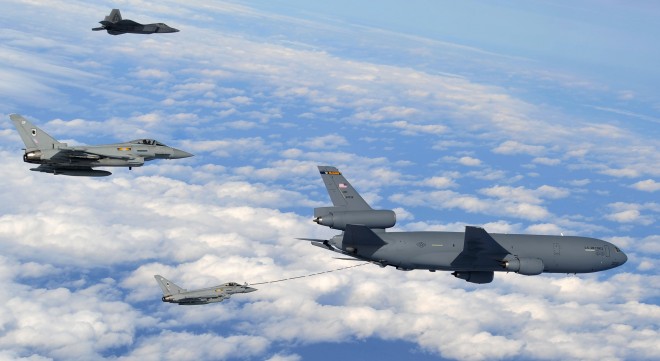
From David Axe, Danger Room: For the first time, America’s top-of-the-line F-22 fighters and Britain’s own cutting-edge Typhoon jets have come together for intensive, long-term training in high-tech warfare. If only the planes could talk to each other on equal terms.
The F-22 and the twin-engine, delta-wing Typhoon — Europe’s latest warplane — are stuck with partially incompatible secure communications systems. For all their sophisticated engines, radars and weapons, the American and British pilots are reduced to one-way communication, from the Brits to the Yanks. That is, unless they want to talk via old-fashioned radio, which can be intercepted and triangulated and could betray the planes’ locations. That would undermine the whole purpose of the F-22′s radar-evading stealth design, and could pose a major problem if the Raptor and the Typhoon ever have to go to war together.
The F-22-Typhoon training is a big deal for both air forces. Previous encounters between U.S. Raptors and Typhoons from the U.K. and Germany were brief and, some say, rigged to handicap the arguably more capable F-22, widely considered the best aerial fighter ever. Operation Western Zephyr, as the combined American-British aerial training is known, essentially merges separate flying squadrons from both air arms for unprecedented levels of cooperation.
Eight Typhoon FGR.4s and 200 personnel from the RAF’s XI Squadron are spending more than a month with the 40 or so F-22s of the U.S. Air Force’s 1st Fighter Wing, based in Virginia. The Raptors and Typhoons have flown mock battles against supersonic Air Force T-38s and Navy F/A-18 Hornets. And on Feb. 7, the F-22s and Typhoons flew to North Carolina to join a wide-ranging simulated air war also involving F-15s, F-16s and aerial tankers.
Next, the Raptors and Typhoons will travel together to Nevada to participate in Red Flag, the Air Force’s main war game, scheduled for late this month. . . .
The F-22 was designed during the Cold War to be a solitary hunter, able to silently swap radar-based targeting data only with other F-22s using a special, hard-to-intercept radio datalink. Accordingly, the Raptor does not have the full Link 16 datalink installed on the Typhoons and many other Western fighters, support planes, warships and ground-based air defenses. Link 16 is what allows different air, sea and ground forces from the U.S. and its allies to securely swap information back and forth during wartime.
To be clear, the F-22 can receive Link 16 data — and has done so with the Typhoons. “That information in addition to other systems was used for coordinating tactical actions during the training,” Lt. Col. Tadd Sholtis, an Air Force spokesman, tells Danger Room. But the F-22s did not transmit targeting data back to the Typhoons, Sholtis says. In short, an F-22 pilot can see what a Typhoon pilot sees on his radar, but not vice versa. (photo: USAF)
Image: USAF%202%2020%2013%20F%2022%20Eurofighter.jpg
